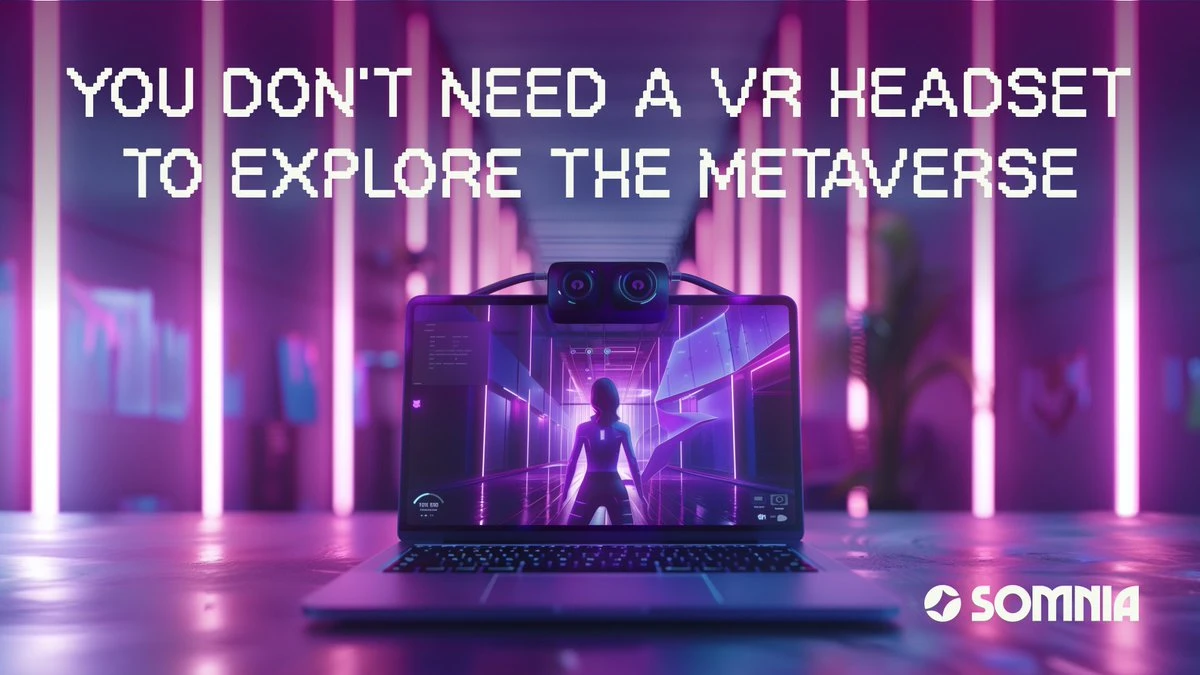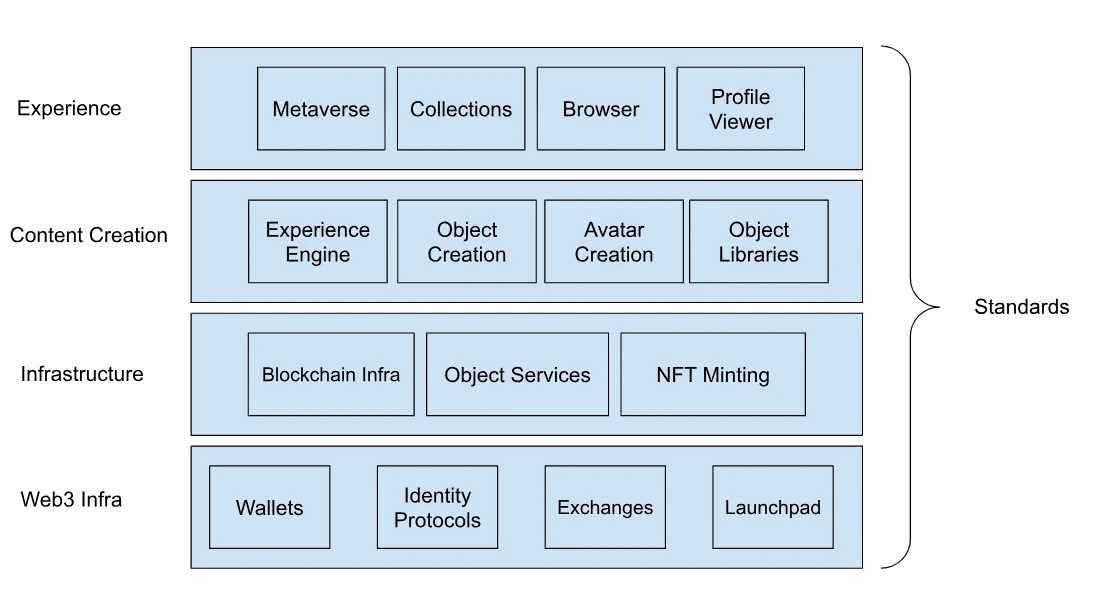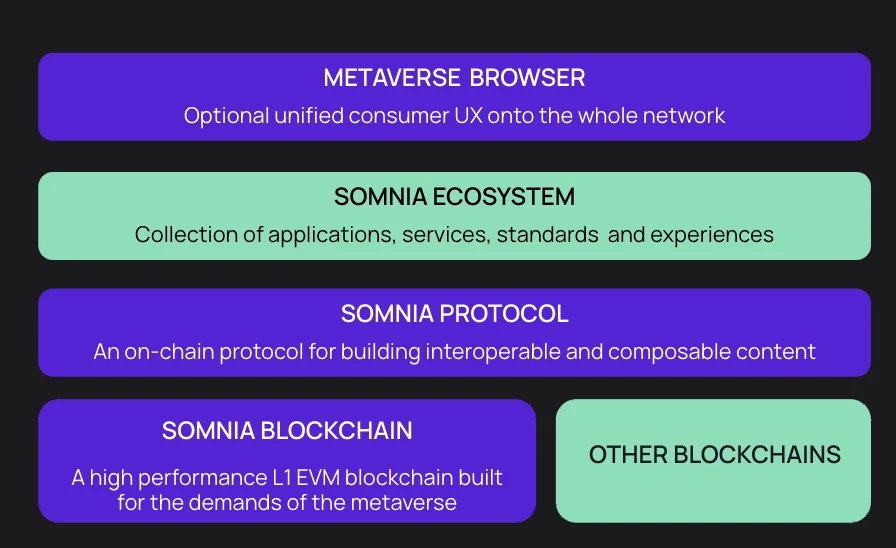In-depth analysis of Somnia: L1 public chain and full-chain protocol carrying the creator economy metaverse
Original锝淥daily Planet Daily
Author: Wenser

As we enter 2024, AI is developing in full swing, and with it comes the huge impact of AIGC (artificial intelligence generated content) on the creator economy. While metaverse giants such as Roblox and Meta have shifted their business focus to other areas, creators, as core producers of the information world, are in urgent need of new solutions so that their hard-earned content can get the rewards it deserves.
In response to the current economic difficulties faced by many creators and the problem of missing content in the blockchain information network, Somnia, with the L1 public chain + full-chain protocol + metaverse browser trinity ecosystem as its core, is expected to become a post-metaverse era game changer that carries the creator economy.
1. In the post-metaverse era, what are the economic prospects for creators?
In 2021, the Metaverse craze, which was launched by companies such as Roblox and Meta and focused on multiplayer online interaction and social entertainment as the main scenarios, was in the spotlight. However, three years later, Robloxs market value has fallen by nearly 50% from its peak and its annual losses are still expanding; the emergence of LLama 3 also announced that Metas business focus has shifted to the AI track. As the pre-Metaverse era gradually comes to an end, building a post-Metaverse era that solves the dilemma of creators and information content problems has gradually become an increasingly urgent need.
Looking back, the current Metaverse and Creator Economy track mainly faces the following specific problems:
1. Economic return rate challenge
Due to the early preparation and long-term planning of the project, the development cycle and development cost of the Metaverse project is often an issue that is difficult to avoid. In particular, many Metaverse projects are currently mainly developed based on the ideas of traditional games and social platforms, and often fall into a contradiction between cost investment and economic returns, which in turn leads to project failure or even death.
2. Centralized platform control
Excessive centralization is another problem that needs to be solved urgently. Just as many social media platforms monetize the value of content created by content creators in the form of advertising, many participants and creators cannot get the rewards they deserve, which eliminates their enthusiasm for innovation and creation. Many previous cases have also verified that metaverse projects controlled by centralized platforms often run counter to the free and open spirit of the metaverse.
3. Web3 Metaverse Project is Immature
Although Web3 Metaverse projects are emerging in an endless stream, they are still difficult to achieve in the short term the decentralization, co-construction and sharing, and ecosystems with clear rules promised by some projects due to the insufficient performance of the blockchain network, the lack of clear universal standards, and insufficient independent scalability. Therefore, they are still immature in actual practice.
4. It is difficult to establish a closed loop for creator economy
Previous Metaverse projects have paid little attention to the online experience of creators and users. First, there are no clear creation guidelines and a clear incentive system plan; second, creators and users are confused and there is no clear role stratification; third, it is impossible to establish a flexible and effective closed loop of production and consumption relationship between consumers-content products-creators.
Therefore, the final result is that the existing Metaverse projects are highly homogenized and have the following defects:
(1) Failure to provide users and creators with a high-quality online metaverse experience;
(2) The inability to integrate online worlds and economic systems into an interconnected metaverse world;
(3) It is impossible to establish a metaverse ecosystem that can empower users and creators and have long-term investment value.

Somnia official website interface
2. Provide a bigger stage for dreamers
In response to the above problems, Somnia is committed to building a new metaverse virtual society that serves the creator economy, different from the previous project-based operation system of many metaverse projects. It is positioned in the L1 public chain ecosystem and divides the solution into 4 levels, which mainly include:
1. Improve blockchain network performance
Thinking from the first principles, the metaverse that can carry the creator economy must inevitably undergo revolutionary breakthroughs and changes at the level of the underlying infrastructure. Based on the operating logic of many operating modes such as on-chain creation, on-chain transactions, on-chain consumption, and on-chain circulation, a blockchain network that can handle larger orders of magnitude, accommodate more users, and serve individual users with different service needs is essential.
2. Create a common rules protocol
An open, free, creative and innovative metaverse requires a series of universal rules and protocols as the underlying architecture to help people, things and objects in the metaverse understand each other and interact efficiently, making it highly interoperable and composable, so as to continuously expand and enrich this virtual society.
3. Define spatial object standards
On the basis of the underlying general protocol, specific standards for multiple objects such as corresponding application ecology, specific content, and spatial products should also be established. Just as designers need to use different color numbers and tones to determine specific design requirements and produce final design products, clear object standards will help speed up the construction of the metaverse and avoid various contradictions and hidden dangers caused by inconsistent internal rules.
4. Establish an efficient incentive system
The establishment of a virtual society in the metaverse is a long-term endeavor, and therefore requires more people to participate in its construction. Therefore, an incentive system that encourages sharing and ensures corresponding value returns to ecosystem participants is imperative. Only in this way can a network effect be gradually generated, attracting more creators, consumers, and brands, products, and platforms from different fields to enter and become part of this decentralized network.
Combined with the low threshold advantage of Somnia that people can enter the metaverse world without the help of VR headsets , a metaverse virtual society consisting of rich scene experiences, interconnected metaverse block networks, and an economic system that empowers each other and has growth potential has become possible. At that time, participants in the Somnia metaverse will be able to establish a real business system without having to go down the old path of the past – relying solely on the survival of a large-scale game business.

Source: Somnia official account
To some extent, with the help of various products built in layers, such as Web3 underlying systems (including wallets, identity protocols, trading platforms, Launchpad), infrastructure construction (including blockchain basic networks, object services, NFT casting applications), content creation (experience engines, object creation, avatar creation, object archives), and scene experience (metaverse space, NFT collection, metaverse browser, profile viewer), Somnia has been able to establish many ecological and industry operating standards. Through modular thinking + layered structure, it has achieved further compression of development costs and risks of composable economic systems, transforming a centralized platform business from a traditional perspective into a new decentralized network architecture, providing a new solution to the dilemma of the post-metaverse era.

Somnias four-layer architecture system consists of ecology and industry standards
3. Virtual social practice supported by resources and technology
The reason why Somnia can embark on a new path different from previous metaverse projects is mainly due to the sufficient technical reserves and strong resource support behind it.
It is understood that Somnia was founded by the Virtual Society Foundation (VSF), which is supported by the British startup Improbable and its subsidiary MSquared. As a star technology company that created the well-known computing platform SpatialOS, Improbable received US$150 million in financing from a number of well-known investment institutions such as a16z, SoftBank, Mirana Ventures, CMT Digital and SIG in 2022. It is worth mentioning that many NFT players may have an impression of the company. Yuga Labs is cooperating with it to develop the metaverse project Otherside, and has successfully tested more than 15,000 players interacting simultaneously in virtual space. Somnia is a powerful complement to Improbable and MSquareds previous vision of building an open, community-owned metaverse, and therefore has made a lot of technical contributions.
The technical elements that Somnia is currently building mainly include:
-
The Somnia Blockchain: This is a high-performance L1 blockchain network built for the high-performance, low-cost operation required by the Metaverse, and is compatible with the EVM network.
-
Somnia Protocol: A protocol for defining all people, places, and objects in a blockchain network and their operating logic. This protocol will help achieve interoperability and compatibility across the metaverse, and increase its scalability and flexibility to a certain extent.
-
Somnia Ecosystem: A collection of applications, services, rules and experiences built on top of the blockchain network and protocols.
-
Metaverse Browser: A web front-end interface for interacting with all products on the Somnia network and applications. (Just like the relationship between the social protocol Farcaster and the application client Warpcast).
Specifically, in terms of achieving large-scale transaction data throughput, the Somnia blockchain has made the following optimization improvements:
-
Independent Datachain: Each validator can run its own blockchain or datachain, allowing independent block production. This approach eliminates the need to establish a consensus mechanism in a single datachain, thereby simplifying the data processing workflow.
-
Consensus chain: A single blockchain aggregates the head operations of all data chains and uses a modified Hotstuff algorithm to prove equity consensus. This structure separates data production from the consensus process, greatly improving overall efficiency.
-
Compiling Bytecode: By converting EVM bytecode into highly optimized native code, Somnia achieves execution speeds close to that of handwritten C++ contracts, making it possible to execute millions of transactions per second on a single core.
-
Advanced Compression Technology: The Somnia data chain architecture achieves a streaming compression effect by combining it with BLS signature aggregation to achieve extremely high compression ratios, thereby enabling massive transaction data throughput, making the theoretical performance higher than the bandwidth limit of other blockchain networks.
-
State-optimized management: Somnia abandons the traditional full-state Merkle tree and instead uses two smaller, cache-friendly Merkle trees to speed up state updates by leveraging different light clients.
Imagine that, based on the above resources and technical reserves, Somnia is expected to build a metaverse world like this:
First, in terms of interconnected ecological networks, through standardized infrastructure including Metaverse Markup Language (MML) and MSquared Origin Engine, Somnia can help creators, IP copyright holders, brands and other commercial entities to achieve cross-platform transfer of assets, businesses and digital avatars, and promote the diversified combination of digital content.
Secondly, in terms of co-construction and sharing of content creation, creators can innovate and re-produce existing works. Whether it is Metaverse event components (such as concerts, light shows, fireworks displays and other event-related props), or digital avatars, digital products, digital information and other content (such as avatars, Metaverse images, Metaverse accessories, Metaverse social media materials, etc.), the original creators can earn royalties through micro-transactions, the secondary creators can obtain corresponding sales revenue, and consumers can obtain unique scene experiences, achieving a win-win situation for all parties.
Thirdly, in terms of real interactive scene carriers, upgradeable NFTs can give existing 2D NFT images souls, allowing them to run freely in the metaverse as 3D objects. Somnia can provide free upgrades for specific NFT projects to meet the display, performance and identity verification needs of NFT holders. Not only that, the construction of a metaverse world with different NFT themes will also become possible from impossible.
Finally, in terms of the creator economic model that encourages innovation, Somnia attaches great importance to the decentralized economic structure and the contributions of high-quality creators. With the help of community-driven governance, the accrued value is returned to the actual innovators, further incentivizing the vigorous development of innovative use cases.

Somnia Metaverse World Components
4. Diversified expansion of content consumption scenarios
Of course, resource funding and technological application are just the beginning. The emergence of the creator economy metaverse is naturally inseparable from various forms of content consumption scenarios. After all, as the saying goes, no experience, no consumption – the novel experience composed of different high-quality content is the best reason to attract more users, creators and commercial entities to join, because this will generate sufficiently attractive hot topics, eye-catching marketing events, unforgettable large-scale events, and so on.
MSquareds past experience will lay a solid foundation for this part, including the official virtual metaverse baseball stadium created in cooperation with the Major League Baseball (MLB) organization, the virtual space music party ( Kosmopop ) held in cooperation with Universal Music and Korean pop musician TWICE, and the Web3 game metaverse Project Edison co-created in cooperation with Web3 industry celebrity Board Elon Musk who has 1.6 million fans, the football-focused metaverse virtual venue Victory League and other different types of cooperation , etc., covering multiple fields such as sports, entertainment, and fan economy.
In these scenarios, users can purchase digital collections, enjoy online competitions, listen to the latest albums, participate in competitive games, and interact with celebrities in their digital identities, which greatly expands the audio-visual experience, enriches the forms of interaction, and broadens the carriers of information dissemination. At a time when the average online time of the global Internet is gradually increasing, increasingly diversified digital content consumption will gradually become the mainstream, which is also the direction of Somnias gradual expansion and the goal it strives to achieve.
It is understood that Somnia has now entered the Beta testing network phase , allowing early community members (with a special name, Somniacs, which can be understood as dream makers and dream chasers) to experience immersive digital spaces in the Somnia ecosystem and try out interoperable NFT avatars and large-scale online gatherings in large-scale metaverse events.

Somnia official blog interface
5. Looking forward to Somnia鈥檚 dream journey
As the main force behind Somnia, Improbable, founded in 2012, has been working in the field of large-scale simulation virtual world construction for 12 years. Somnia carries the latest and highest expectations of this technology unicorn.
Different from the small-scale individual projects in the past, Somnia is an open world that integrates many elements such as creator economy + composable content + upgradeable NFT + multi-platform ecology. It is also a comprehensive ecology positioned on L1 public chain and full-chain protocol. Therefore, it involves MSquared Origin platform (based on Unreal Engine, basic application for high-performance experience), open source web engine, self-hosted server running Unreal or Unity, MML Editor, Meshy.ai, Avatrun, Ready Player Me, MSquared avatar generator, IPFS, Arweave, EIP-4337 account abstraction standard, AMM, CLOB and many other tool applications and underlying infrastructure across Web2 and Web3 fields.
In the near future, when the Somnia Beta test network ends and the main network is launched, combined with the previous commercial resource potential, Somnia is expected to set off a new round of attention and enthusiasm in the metaverse field and related industries such as games, events, sports, entertainment, fashion, etc.
By then, a virtual dream woven by many dream makers will slowly unfold in front of more people. Let us look forward to it together.
This article is sourced from the internet: In-depth analysis of Somnia: L1 public chain and full-chain protocol carrying the creator economy metaverse
Related: Aptos (APT) Recovery Effort: Can Price Overcome Recent Multi-Week Lows?
In Brief Aptos price is exhibiting signs of recovery after noting a 36% decline in two weeks. Over $1 million worth of long contracts have been liquidated in the last 24 hours, and such instances have historically been followed by recovery. MACD and RSI are displaying signs of reversal, which will be confirmed once $12.67 is flipped into support. Aptos (APT) price has had a rough couple of days, bringing the altcoin down to a multi-week low. APT is now attempting a recovery, which could be redemption for the bullish investors. Aptos Sees Green Aptos’ price trading at $12.43 bounces off the support line at $12.04. This is an opportunity for bullish investors as they have suffered considerably over the last few days. This is evident from the liquidation data,…






